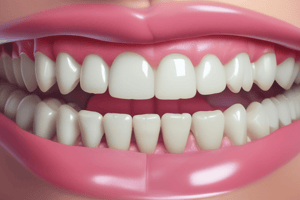Podcast
Questions and Answers
In non-extraction cases, when is the Progress Review often scheduled?
In non-extraction cases, when is the Progress Review often scheduled?
- After the incisor relationship has been corrected
- At the beginning of treatment
- When we are ready to move into working wires (correct)
- At the end of space closure
What is the potential issue with the lower incisor brackets?
What is the potential issue with the lower incisor brackets?
- They have incorrect in-out values (correct)
- They are too thin
- They are based on outdated research
- They are only suitable for extraction cases
What is the benefit of using precise brackets in treatment?
What is the benefit of using precise brackets in treatment?
- They help to prevent overcorrection
- They reduce the need for wire changes
- They are easier to place
- They improve the progress of treatment and the outcome (correct)
In which situation may there be a risk of overcorrection?
In which situation may there be a risk of overcorrection?
What is the remedy for upper and lower incisor roots being a little forward?
What is the remedy for upper and lower incisor roots being a little forward?
Why might a doctor choose to use zero torque brackets for lower incisors?
Why might a doctor choose to use zero torque brackets for lower incisors?
What is recommended when switching to an indirect bonding system?
What is recommended when switching to an indirect bonding system?
What has made indirect bonding easier?
What has made indirect bonding easier?
When should the Progress Review be scheduled in more challenging cases?
When should the Progress Review be scheduled in more challenging cases?
What is a potential issue with using precise brackets?
What is a potential issue with using precise brackets?
Flashcards are hidden until you start studying
Study Notes
Bracket Positioning and Treatment Checks
- Regular assessment of bracket positions ensures optimal treatment outcomes and assists in identifying errors early.
- Utilization of radiographs and progress models supports accurate evaluations and file corrections.
- Documenting ongoing case requirements simplifies the finishing process and can reduce overall treatment duration.
Finishing Protocols
- The finishing stage of orthodontic treatment can be complex, prompting a developed protocol to enhance efficiency.
- The protocol consists of correcting pre-finishing errors, overcorrecting critical malocclusion features, and facilitating case settling.
- Minimization of adverse changes is vital while teeth adjust during the final stage of treatment.
Progress Review
- A 'Progress Review' appointment is advised post-major tooth movements, streamlining the closing phase.
- Timing for the review varies based on case difficulty, often scheduled during transition to working wires or towards the end of extraction treatment.
- This appointment focuses on ensuring comprehensive final adjustments, referred to colloquially as 'Clean up time'.
Clinical Considerations
- Switching lower canine brackets can optimize mechanics in Class III treatments, altering the bracket tip angle.
- For buccally ectopic upper canines, utilizing a +7° torque bracket may offer better root positioning than the standard -7° bracket.
Bracket and Wire Adjustments
- Precise brackets enhance treatment outcomes, albeit with some considerations for specific clinical scenarios.
- In certain cases, forward positioning of incisor roots may occur, necessitating a downgrade in wire size for correction.
- Indirect bonding systems (IDBS) are evolving with newer materials, and collaboration with experienced practitioners is advised for successful transition.
Additional Queries
- Incorporating hooks on canine and premolar brackets is suggested to facilitate treatment flexibility according to individual case needs.
- Precise alignment is generally achieved without extensive first-order bends, affirming bracket accuracy despite perceived thickness.
Studying That Suits You
Use AI to generate personalized quizzes and flashcards to suit your learning preferences.





